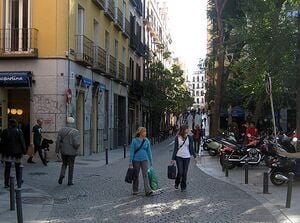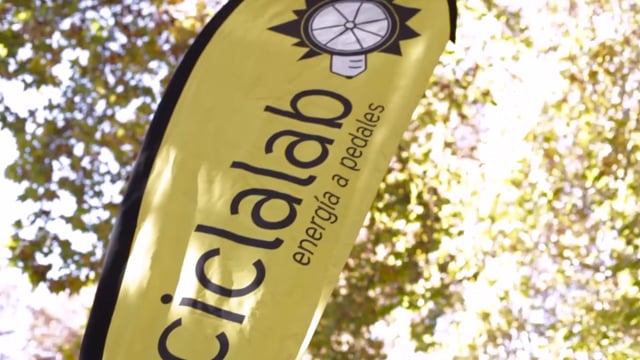
 The eye-popping new school designed by its pupils, Positive News (Apr 12, 2023)
The eye-popping new school designed by its pupils, Positive News (Apr 12, 2023)
Networks and sustainability initiatives[edit | edit source]
- Neighbourhood initiatives across Madrid
- Los Madriles, Atlas de iniciativas vecinales (Atlas of neighbourhood initiatives), "What you have in front of you is an unfinished atlas of Madrid and its neighbourhood initiatives that have created new spaces of possibility, through self-management and participation. It also wants to be a gesture of recognition, gratitude, visibility, self-criticism and inclusion." latest news item Jan 2019, content available under a creative commons license
- Centro de Resiliencia de Aranjuez, closed 2017, content available under a creative commons license
Community resources[edit | edit source]
- Community Lovers Guide, Madrid
- El Campo de Cebada, Madrid, 2010; on facebook
Environment quality[edit | edit source]
The mandate of left-wing Mayor Manuela Carmena (2015–2019) delivered the renaturalization of the course of the Manzanares across the city. W
Open spaces[edit | edit source]
Madrid ( mə-DRID, Spanish: [maˈðɾið] ) is the capital and most populous city of Spain. The city has almost 3.4 million inhabitants and a metropolitan area population of approximately 7 million. It is the second-largest city in the European Union (EU), and its monocentric metropolitan area is the second-largest in the EU. The municipality covers 604.3 km2 (233.3 sq mi) geographical area. Madrid lies on the River Manzanares in the central part of the Iberian Peninsula at about 650 meters above mean sea level. The capital city of both Spain and the surrounding autonomous community of Madrid (since 1983),: 44 it is also the political, economic, and cultural centre of the country. The climate of Madrid features hot summers and cool winters.
The Madrid urban agglomeration has the second-largest GDP in the European Union and its influence in politics, education, entertainment, environment, media, fashion, science, culture, and the arts all contribute to its status as one of the world's major global cities. Due to its economic output, high standard of living, and market size, Madrid is considered the major financial centre and the leading economic hub of the Iberian Peninsula and of Southern Europe. The metropolitan area hosts major Spanish companies such as Telefónica, Iberia, BBVA and FCC.: 45 It concentrates the bulk of banking operations in the country and it is the Spanish-speaking city generating the largest number of webpages.: 45 For innovation, Madrid is ranked 19th in the world and 7th in Europe from 500 cities, in the 2022–2023 annual analysts Innovation Cities Index, published by 2ThinkNow.
Madrid houses the headquarters of the UN's World Tourism Organization (UNWTO), the Ibero-American General Secretariat (SEGIB), the Organization of Ibero-American States (OEI), and the Public Interest Oversight Board (PIOB). It also hosts major international regulators and promoters of the Spanish language: the Standing Committee of the Association of Spanish Language Academies, headquarters of the Royal Spanish Academy (RAE), the Instituto Cervantes and the Foundation of Urgent Spanish (FundéuRAE). Madrid organises fairs such as FITUR, ARCO, SIMO TCI and the Madrid Fashion Week. Madrid is home to two world-famous football clubs, Real Madrid and Atlético Madrid.
While Madrid possesses modern infrastructure, it has preserved the look and feel of many of its historic neighbourhoods and streets. Its landmarks include the Plaza Mayor, the Royal Palace of Madrid; the Royal Theatre with its restored 1850 Opera House; the Buen Retiro Park, founded in 1631; the 19th-century National Library building (founded in 1712) containing some of Spain's historical archives; many national museums, and the Golden Triangle of Art, located along the Paseo del Prado and comprising three art museums: Prado Museum, the Reina Sofía Museum, a museum of modern art, and the Thyssen-Bornemisza Museum, which complements the holdings of the other two museums. Cibeles Palace and Fountain has become one of the monument symbols of the city. The mayor is José Luis Martínez-Almeida from the People's Party.
The origin of the name is unknown. There are various theories regarding the origin of the toponym "Madrid" (all of them with problems when it comes to fully explaining the phonetic evolution of the toponym), namely:
Trees, woodland and forest[edit | edit source]
Across the Manzanares, lies the Casa de Campo, a large forested area with more than 1700 hectares (6.6 sq mi) where the Madrid Zoo, and the Parque de Atracciones de Madrid amusement park are located. It was ceded to the municipality following the proclamation of the Second Spanish Republic in 1931.[128]
The Monte de El Pardo is the largest forested area in the municipality. A holm oak forest covering a surface over 16,000 hectares, it is considered the best preserved mediterranean forest in the Community of Madrid and one of the best preserved in Europe.[129] Already mentioned in the Alfonso XI's Libro de la montería [es] from the mid-14th century, its condition as hunting location linked to the Spanish monarchy help to preserve the environmental value.[129] During the reign of Ferdinand VII the regime of hunting prohibition for the Monte de El Pardo became one of full property and the expropriation of all possessions within its bounds was enforced, with dire consequences for the madrilenians at the time.[130] It is designated as Special Protection Area for bird-life and it is also part of the Regional Park of the High Basin of the Manzanares.
Other large forested areas include the Soto de Viñuelas, the Dehesa de Valdelatas [es] and the Dehesa de la Villa [es]. As of 2015, the most recent big park in the municipality is the Valdebebas Park. Covering a total area of 4.7 km2 (1.8 sq mi), it is sub-divided in a 3.4 km2 (1.3 sq mi) forest park (the Parque forestal de Valdebebas-Felipe VI [es]), a 0.8 km2 (0.31 sq mi) periurban park as well as municipal garden centres and compost plants. W
Community involvement[edit | edit source]
Cycling[edit | edit source]
BiciMAD is a bicycle sharing system in Madrid, Spain. It is currently provided by the Empresa Municipal de Transportes de Madrid, a public company owned by the City Council of Madrid.
The service, originally granted to Bonopark SL, began operations on 23 June 2014. It was municipalized by the City Council on 17 May 2016. BiciMAD reached the number of 16,000 daily transportations for the first time in September 2018. As of March 2021, the system comprises 2964 bikes and 264 stations.
- bicimad.com
- by bike in Madrid, (blog)
Food activism[edit | edit source]
- Network of Urban Gardens of Madrid, The creation of the Network arose to make urban agriculture in Madrid visible, to respond to the needs of urban gardens to receive mutual support and share knowledge, experiences, inputs, etc.
- One of the objectives of the network is to create a meeting point between community agroecology initiatives in our city and move towards a friendlier city model that is interested in issues such as environmental education, food sovereignty, open distribution channels of products, consumer groups, sustainable mobility, agrocomposting, etc. content available under a creative commons license
Sustainable transport activism[edit | edit source]
About Madrid[edit | edit source]
Madrid ( mə-DRID, Spanish: [maˈðɾið] ) is the capital and most populous city of Spain. The city has almost 3.4 million inhabitants and a metropolitan area population of approximately 7 million. It is the second-largest city in the European Union (EU), and its monocentric metropolitan area is the second-largest in the EU. The municipality covers 604.3 km2 (233.3 sq mi) geographical area. Madrid lies on the River Manzanares in the central part of the Iberian Peninsula at about 650 meters above mean sea level. The capital city of both Spain and the surrounding autonomous community of Madrid (since 1983),: 44 it is also the political, economic, and cultural centre of the country. The climate of Madrid features hot summers and cool winters.
The Madrid urban agglomeration has the second-largest GDP in the European Union and its influence in politics, education, entertainment, environment, media, fashion, science, culture, and the arts all contribute to its status as one of the world's major global cities. Due to its economic output, high standard of living, and market size, Madrid is considered the major financial centre and the leading economic hub of the Iberian Peninsula and of Southern Europe. The metropolitan area hosts major Spanish companies such as Telefónica, Iberia, BBVA and FCC.: 45 It concentrates the bulk of banking operations in the country and it is the Spanish-speaking city generating the largest number of webpages.: 45 For innovation, Madrid is ranked 19th in the world and 7th in Europe from 500 cities, in the 2022–2023 annual analysts Innovation Cities Index, published by 2ThinkNow.


